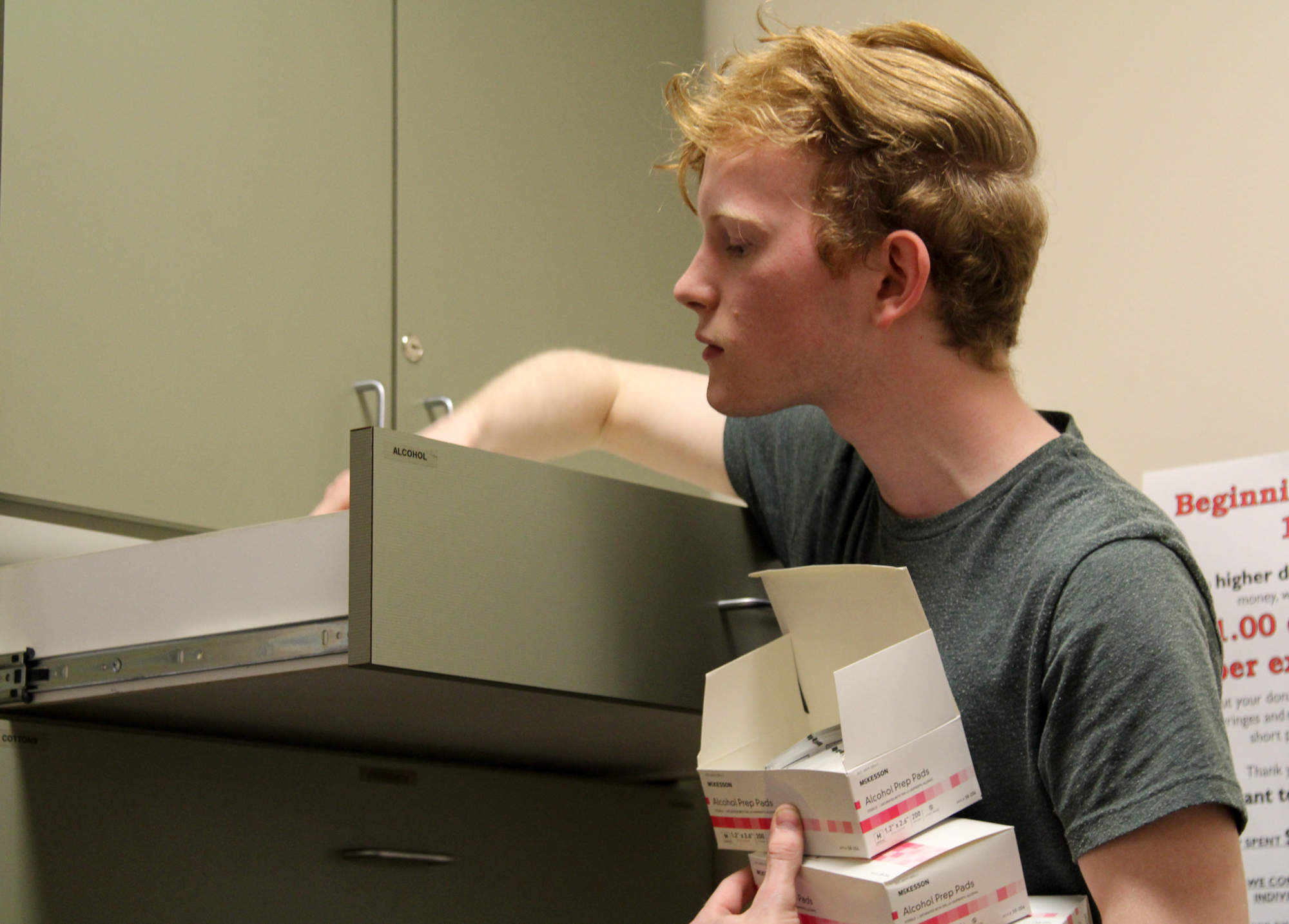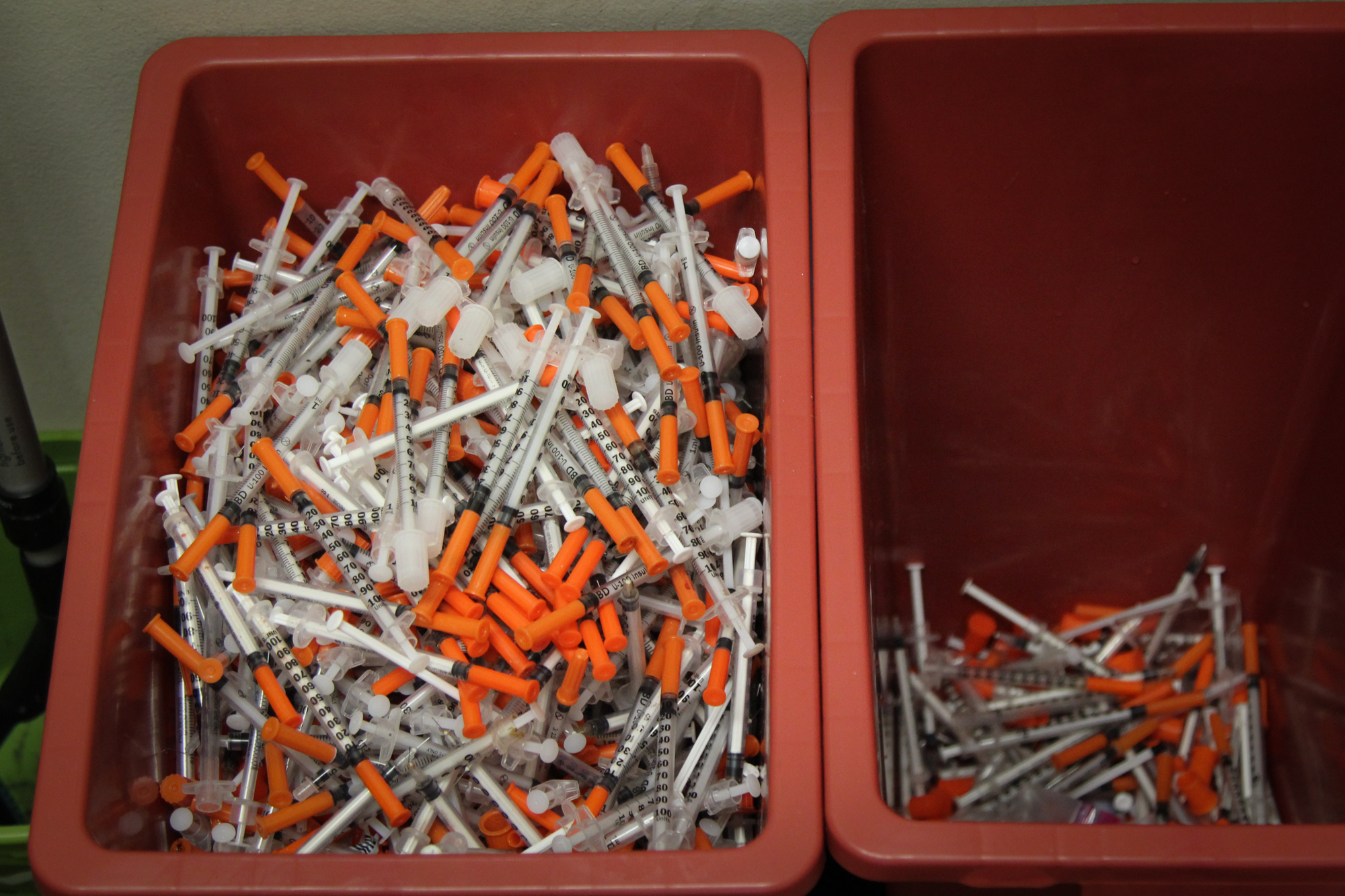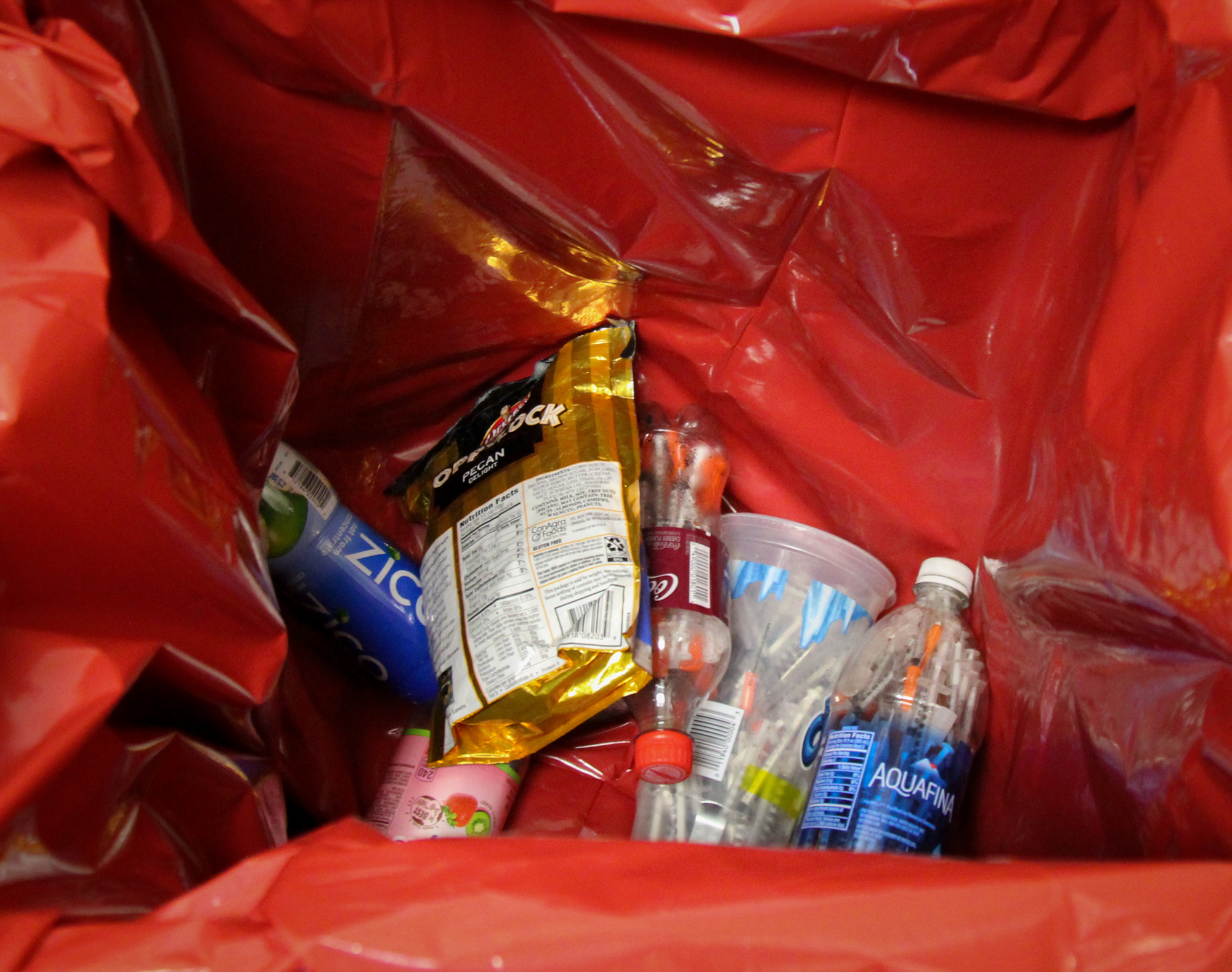
There is an abundance of jaw-dropping numbers when it comes to opioids in Alaska. Seventy-four percent of the state’s drug overdose deaths last year are attributed to prescription painkillers or heroin. Blood-born viruses like hepatitis C are exploding, and so are healthcare costs. One calculation estimated that to treat all the Alaskans who contracted hep C from injecting drugs in 2015 would cost $90 million.
Here’s another figure: the number of syringes exchanged at one Anchorage non-profit doubled in just two years.
In 2016, the program gave out slightly less than a half-million clean needles. And disposed of even more.
This year they’re on track to outpace that.
The program is a way of reducing health risks and long-term medical costs, but it isn’t without controversy.
Syringe exchange
On a recent Friday afternoon inside the Spenard office of the Alaska Aids Assistance Association, or the 4A’s, a 40-year-old man emptied a plastic vodka bottle stuffed with 31 needles. He was using scissors to cut open the bottle neck as a volunteer ran through a few standard questions.
“Gender?” The volunteer asked. “I’m male,” he answered, not looking up. “What’s your ethnicity?” “I’m white.” “Are you getting these for others?” “Yeah,” the man answered. “Two or three.”
“Great!” the volunteer replied before dropping a few packs of needles into a brown paper bag.
Alaska Aids Assistance Association runs the largest syringe exchange in the state.
Basic demographic is collected every time someone comes in to trade used syringes for new ones.
If a person’s new, or has no syringes to exchange, they get a “starter pack” of five, and however many cotton balls, alcohol swabs, tourniquets and small metal cookers they need.
It’s all anonymous — no one has to give his or her name. The exchange will only give out 50 needles to a person per day, a limit they had to impose to keep up with demand.
Friday afternoons are generally the busiest time for the exchange, according to Zane Davis, who volunteers for the shift every week.
“People are prepping for the weekend,” Davis said. “There are a lot of people who just wait until Friday and then they use over the weekend, so they’ve really got to come in and stock up.”

Data collection
Within just a few hours, dozens of people come through. Two red trash cans gradually fill with orange-capped plastic needles. A cardboard box in the corner takes on a Big Gulp, Gatorade and soda bottles packed with syringes. The plastic containers are puncture proof, so its a safe way to carry needles and not get stuck.
Since 4A’s collects data at each exchange, they have a lot of information about who’s using the program. Last year, they gave out 479,177 syringes. They almost surpassed that figure 10 months into this fiscal year.
They see a stable base of about 2,200 users, but every month around 70-90 new people come in for the first time.
Most are picking up syringes for themselves. But plenty are getting them for others: Friends, partners, siblings.
One such person is a young man from north Anchorage who just wants to use his first name, John. He was picking up supplies for his brother, whom he’s trying to help.
“I’m keeping him at my place to clean him out, wean him down,” John said during a brief interview in a side office. He couldn’t stay long: his grandmother was waiting in the car outside, and it was a hot afternoon.
John knows the exchange well because he came here during his own addiction.
His path to heroin started like a lot of people’s across the country: first with painkillers that a doctor legally prescribed him for a back injury.
“Made me go down the rabbit hole,” John said. When his prescription ran out he unexpectedly went through withdrawal symptoms. “Started out with pills, and it went to heroin — smoking heroin. Then it went to shooting heroin.”
John sold everything he owned and bankrupted his business. His marriage of 12 years collapsed, and he lost his four daughters.
It took isolating himself in a cabin for over a month to get off heroin. He hasn’t used in eight months.
John is like a lot of the people who come to the exchange. The vast majority, 75 percent, are 20-40 years old. He’s white and male, which respectively account for 62 and 57 percent respectively of the 17,614 exchanges that happened last year.
(Another 24 percent of exchanges are with people who identify as Alaska Native, which is disproportionately high relative to the state population.)

Reducing harm
Near closing time at 5 p.m., more people started showing up.
Eventually the woman at the front desk started inputting people’s data into her own computer and sending them to the exchange room with a hand-written Post-it note telling Davis which supplies give them.
Some people were anxious and rushed. Most were exceptionally polite. Many had on work clothes: stained jeans, mud-caked Xtratufs. They were coming from or going to their jobs: a painter, a heavy equipment operator, a bartender.
One woman in her 50s dumped 120 needles into a bin, explaining she collects and gives out syringes to to keep acquaintances from re-using the same ones.
“If they have to re-use them, tell them to put it in bleach for 10 minutes,” Davis said in a concerned tone.
“I know a lot of people who get infections from re-using,” the woman told him. “That’s why I try to say, ‘Hey! Here!’ and pass them out.”
Programs like this are criticized for enabling drug use.
Advocates say people are already addicted by the time they start showing up at needle exchanges, and the goal is to reduce further harm they could do to themselves or others in the course of injecting drugs.
The tip of a needle drastically dulls after each use, which can damage veins and makes infections more likely — infections which can spread if syringes are shared.
Public health officials also point out these programs are shown to funnel a portion of drug users toward health care and treatment they wouldn’t otherwise encounter.
A pre-med student at the University of Alaska Anchorage, Davis volunteers here in part because he believes it’s an effective way to limit the spread of disease as people cope with addiction.
“I think providing them with clean, safe supplies for free is the best way to prevent them from hurting themselves and the community more than they already are,” Davis said.
Davis is not alone on this point.
Alaska’s own Opioid Policy Task Force recommended expanded funding for for more syringe exchanges, particularly in rural areas.
(Another suggestion was supplying more Nalaxone, the overdose-reversing drug used by individuals and first-responders that is slowing the pace of opioid-related deaths, which 4A’s will give out to people if they go through a 10-minute training)
Few real options
Matt Allen, who coordinates HIV prevention at 4A’s, said the exchange guides many high-risk drug users toward the HIV and hepatitis C testing the non-profit runs on site, just a few feet from where the clean needles are kept.
Last year, 4A’s did 737 tests (however, only a portion of the HIV screenings were of IV-drug users).
“We get positives all the time,” Allen said.
Allen’s surprised by how un-surprised many people are upon receiving a diagnosis.
“They have an inkling that they’re positive,” Allen said. “Not just by showing symptoms, but because of their behaviors of sharing syringes.”
According to Allen, every day they get people who come into the exchange and want help.
“They’ll bring it up,” Allen said. Usually it’s through comments or asides: “‘I’m ready to get off of this,’ or ‘I don’t even want to be here.’ And that really starts the conversation.”
It’s frustrating, because there are few real options.
Often the most they can do is give the person a list of phone numbers for treatment facilities and tell them to call every day until a bed opens up.
Even still, the exchange is a cost-effective measure when it comes to preventing more expensive intervention down the line.
Exploring the costs
The price for curing a virus like hep C with medications is between $85,000 and $94,500. That covers almost a full year of running this syringe exchange.
About half the program’s budget is paying for all the needles to be carted away and incinerated. Just $43,643 was spent on the actual syringes last year.
Money is one of the key reasons syringe exchanges are challenging to run.
It can be a difficult endeavor to fund raise for, and the federal government has been strict about not allowing money to be spent on syringes.
Although recently, some of the purchasing prohibitions on other supplies have relaxed as public officials struggle to cope with the nation-wide opioid epidemic.
Part of the budget for supplies in Anchorage comes directly from people who use the exchange.
Since last March, 4A’s has asked people to give a dollar each time they come in. Not everyone has, but it’s not a requirement.
Plenty of people put handfuls of coins and crumpled bills in a red metal box on the wall.
Seeing the other side
Alaska Aids Assistance Association runs another exchange program in Juneau, and there are two more smaller exchanges in Homer and Fairbanks.
The Anchorage location ends up serving folks from around the state: people from 82 communities in Alaska were given needles last year.
Most people who come in are from Anchorage and the Valley, but villages, hubs, and towns across the Alaska are represented.
In most small communities there’s nowhere to buy syringes.
“It just makes you wonder if they’re just re-using and re-using those same syringes and sharing them,” Allen said.
Davis has an interesting perspective on this.
He grew up in the Matanuska-Susitna Valley, which has seen some of the worst consequences of the state’s opioid crisis.
“I had acquaintances in high school who ended up overdosing,” Davis said. “The Valley is pretty small, so you know pretty much everyone you went to school with, and there were one or two people who died.”
At the time, Davis said people were aware of what was happening but didn’t discuss it.
Davis also is in the unique position of seeing the other side of injection drug use.
His part-time job is in a hospital emergency room, and that’s where he encounters some of the same faces from the exchange.
“It’s not easy to see someone in the ER who’s overdosing who you see really regularly at the exchange and have maybe developed some rapport with them,” Davis said.
When it happens he tries to compartmentalize and focus on whatever task is at hand.
“Usually I end up seeing the patient in the syringe exchange about a week later.”
